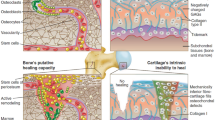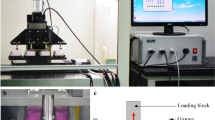Abstract
Purpose
(1) To characterize the effects of mechanical stimulation on the integration of a tissue-engineered construct in terms of histology, biochemistry and biomechanical properties; (2) to identify whether cells of the implant or host tissue were critical to implant integration; and (3) to study cells believed to be involved in lateral integration of tissue-engineered cartilage to host cartilage. We hypothesized that mechanical stimulation would enhance the integration of the repair implant with host cartilage in an in vitro integration model.
Methods
Articular cartilage was harvested from 6- to 9-month-old bovine metacarpal-phalangeal joints. Constructs composed of tissue-engineered cartilage implanted into host cartilage were placed in spinner bioreactors and maintained on a magnetic stir plate at either 0 (static control) or 90 (experimental) rotations per minute (RPM). The constructs from both the static and spinner bioreactors were harvested after either 2 or 4 weeks of culture and evaluated histologically, biochemically, biomechanically and for gene expression.
Results
The extent and strength of integration between tissue-engineered cartilage and native cartilage improved significantly with both time and mechanical stimulation. Integration did not occur if the implant was not viable. The presence of stimulation led to a significant increase in collagen content in the integration zone between host and implant at 2 weeks. The gene profile of cells in the integration zone differs from host cartilage demonstrating an increase in the expression of membrane type 1 matrix metalloproteinase (MT1-MMP), aggrecan and type II collagen.
Conclusions
This study shows that the integration of in vitro tissue-engineered implants with host tissue improves with mechanical stimulation. The findings of this study suggests that consideration should be given to implementing early loading (mechanical stimulation) into future in vivo studies investigating the long-term viability and integration of tissue-engineered cartilage for the treatment of cartilage injuries. This could simply be done through the use of continuous passive motion (CPM) in the post-operative period or through a more complex and structured rehabilitation program with a gradual increase in forces across the joint over time.







Similar content being viewed by others
References
Ahmed N, Gan L, Nagy A, Zheng J, Wang C, Kandel RA (2009) Cartilage tissue formation using redifferentiated passaged chondrocytes in vitro. Tissue Eng Part A 15:665–673
Brittberg M, Lindahl A, Nilsson A, Ohlsson C, Isaksson O, Peterson L (1994) Treatment of deep cartilage defects in the knee with autologous chondrocyte transplantation. N Engl J Med 331:889–895
Carver SE, Heath CA (1999) Influence of intermittent pressure, fluid flow, and mixing on the regenerative properties of articular chondrocytes. Biotechnol Bioeng 65:274–281
Cherry RS, Papoutsakis ET (1988) Physical mechanisms of cell damage in microcarrier cell culture bioreactors. Biotechnol Bioeng 32:1001–1014
Darling EM, Athanasiou KA (2003) Biomechanical strategies for articular cartilage regeneration. Ann Biomed Eng 31:1114–1124
De Croos JN, Jang B, Dhaliwal SS, Grynpas MD, Pilliar RM, Kandel RA (2007) Membrane type-1 matrix metalloproteinase is induced following cyclic compression of in vitro grown bovine chondrocytes. Osteoarthr Cartil 15:1301–1310
Dunkelman NS, Zimber MP, Lebaron RG, Pavelec R, Kwan M, Purchio AF (1995) Cartilage production by rabbit articular chondrocytes on polyglycolic acid scaffolds in a closed bioreactor system. Biotechnol Bioeng 46:299–305
Gilbert SJ, Singhrao SK, Khan IM, Gonzalez LG, Thomson BM, Burdon D et al (2009) Enhanced tissue integration during cartilage repair in vitro can be achieved by inhibiting chondrocyte death at the wound edge. Tissue Eng Part A 15:1739–1749
Goldberg RL, Kolibas LM (1990) An improved method for determining proteoglycans synthesized by chondrocytes in culture. Connect Tissue Res 24:265–275
Gooch KJ, Kwon JH, Blunk T, Langer R, Freed LE, Vunjak-Novakovic G (2001) Effects of mixing intensity on tissue-engineered cartilage. Biotechnol Bioeng 72:402–407
Gross AE, Kim W, Las Heras F, Backstein D, Safir O, Pritzker KP (2008) Fresh osteochondral allografts for posttraumatic knee defects: long-term followup. Clin Orthop Relat Res 466:1863–1870
Horas U, Pelinkovic D, Herr G, Aigner T, Schnettler R (2003) Autologous chondrocyte implantation and osteochondral cylinder transplantation in cartilage repair of the knee joint. A prospective, comparative trial. J Bone Joint Surg Am 85:185–192
Kandel RA, Grynpas M, Pilliar R, Lee J, Wang J, Waldman S et al (2006) Repair of osteochondral defects with biphasic cartilage-calcium polyphosphate constructs in a sheep model. Biomaterials 27:4120–4131
Khan IM, Gilbert SJ, Singhrao SK, Duance VC, Archer CW (2008) Cartilage integration: evaluation of the reasons for failure of integration during cartilage repair. A review. Eur Cell Mater 16:26–39
Kiviranta I, Tammi M, Jurvelin J, Saamanen AM, Helminen HJ (1988) Moderate running exercise augments glycosaminoglycans and thickness of articular cartilage in the knee joint of young beagle dogs. J Orthop Res 6:188–195
Malemud CJ (2006) Matrix metalloproteinases: role in skeletal development and growth plate disorders. Front Biosci 11:1702–1715
Obradovic B, Martin I, Padera RF, Treppo S, Freed LE, Vunjak-Novakovic G (2001) Integration of engineered cartilage. J Orthop Res 19:1089–1097
Pabbruwe MB, Esfandiari E, Kafienah W, Tarlton JF, Hollander AP (2009) Induction of cartilage integration by a chondrocyte/collagen-scaffold implant. Biomaterials 30:4277–4286
Pilliar RM, Filiaggi MJ, Wells JD, Grynpas MD, Kandel RA (2001) Porous calcium polyphosphate scaffolds for bone substitute applications—in vitro characterization. Biomaterials 22:963–972
Reindel ES, Ayroso AM, Chen AC, Chun DM, Schinagl RM, Sah RL (1995) Integrative repair of articular cartilage in vitro: adhesive strength of the interface region. J Orthop Res 13:751–760
Sah RL, Doong JY, Grodzinsky AJ, Plaas AH, Sandy JD (1991) Effects of compression on the loss of newly synthesized proteoglycans and proteins from cartilage explants. Arch Biochem Biophys 286:20–29
Smith RL, Donlon BS, Gupta MK, Mohtai M, Das P, Carter DR et al (1995) Effects of fluid-induced shear on articular chondrocyte morphology and metabolism in vitro. J Orthop Res 13:824–831
Steadman JR, Briggs KK, Rodrigo JJ, Kocher MS, Gill TJ, Rodkey WG (2003) Outcomes of microfracture for traumatic chondral defects of the knee: average 11-year follow-up. Arthroscopy 19:477–484
Taylor DW, Ahmed N, Gan L, Gross AE, Kandel RA (2010) Proteoglycan and collagen accumulation by passaged chondrocytes can be enhanced through side-by-side culture with primary chondrocytes. Tissue Eng Part A 16:643–651
Theodoropoulos JS, De Croos JN, Park SS, Pilliar R, Kandel RA (2011) Integration of tissue-engineered cartilage with host cartilage: an in vitro model. Clin Orthop Relat Res 469:2785–2795
Tognana E, Chen F, Padera RF, Leddy HA, Christensen SE, Guilak F et al (2005) Adjacent tissues (cartilage, bone) affect the functional integration of engineered calf cartilage in vitro. Osteoarthr Cartil 13:129–138
Vunjak-Novakovic G, Martin I, Obradovic B, Treppo S, Grodzinsky AJ, Langer R et al (1999) Bioreactor cultivation conditions modulate the composition and mechanical properties of tissue-engineered cartilage. J Orthop Res 17:130–138
Waldman SD, Grynpas MD, Pilliar RM, Kandel RA (2002) Characterization of cartilagenous tissue formed on calcium polyphosphate substrates in vitro. J Biomed Mater Res 62:323–330
Waldman SD, Spiteri CG, Grynpas MD, Pilliar RM, Hong J, Kandel RA (2003) Effect of biomechanical conditioning on cartilaginous tissue formation in vitro. J Bone Joint Surg Am 85-A(Suppl 2):101–105
Waldman SD, Spiteri CG, Grynpas MD, Pilliar RM, Kandel RA (2004) Long-term intermittent compressive stimulation improves the composition and mechanical properties of tissue-engineered cartilage. Tissue Eng 10:1323–1331
Woessner JF (1976) Determination of hydroxyproline content in connective tissues. In: Hall DA (ed) The methodology of connective tissue research. Johnson-Bruvvers Ltd, Oxford, pp 235–245
Zhang Z, McCaffery JM, Spencer RG, Francomano CA (2005) Growth and integration of neocartilage with native cartilage in vitro. J Orthop Res 23:433–439
Conflict of interest
The authors declare that they have no conflict of interest.
Ethical standards
The manuscript does not contain clinical studies or patient data.
Author information
Authors and Affiliations
Corresponding author
Additional information
This study was conducted at Mount Sinai Hospital, Samuel Lunenfeld Research Institute, Toronto, Canada.
Rights and permissions
About this article
Cite this article
Theodoropoulos, J.S., DeCroos, A.J.N., Petrera, M. et al. Mechanical stimulation enhances integration in an in vitro model of cartilage repair. Knee Surg Sports Traumatol Arthrosc 24, 2055–2064 (2016). https://doi.org/10.1007/s00167-014-3250-8
Received:
Accepted:
Published:
Issue Date:
DOI: https://doi.org/10.1007/s00167-014-3250-8




